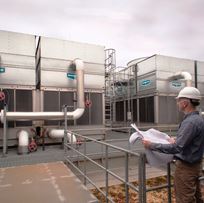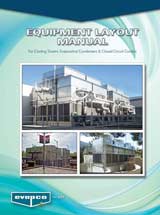Specifying Evaporative Cooling Equipment: A Quick Reference
The intent of this document is to provide a brief overview of the considerations required when selecting either open cooling towers or closed circuit fluid coolers. These systems aren’t overly complex but a plethora of options and configurations exist to meet the needs of each application. This paper is brief to give enough information to help you get started. As always I am here to assist in selections of these systems to ensure application needs are met.
Evapco Equipment Layout Manual
Be sure to download a copy of the Evapco equipment layout guide. This is an essential read for planning the layout of your next evaporative cooling project. Topics including configuration guidelines for multiple unit installations, discharge heights, handling of louvered walls, wells and special enclosures.
Performance
- Condenser Water Flow Rate
- Entering (return) condenser water temperature
- Leaving (supply) condenser water temperature
- Entering (ambient) wet bulb temperature
With the above information we have defined the range, approach and total capacity requirement for the cooling tower.
Configuration
- Open tower or Closed Circuit Cooler
- Fan configuration: Forced Draft or Induced Draft
- Counterflow or Crossflow
Closed-Circuit Cooler vs Open Tower:
- In a closed circuit cooler process fluid is isolated in the closed loop, this ensures a cleaner system over time, allowing for higher overall efficiency of connected
- Dry operation is only possible in a closed circuit system, this conserves water and treatment chemicals. This will also prevent icing and plume. Capacities of approximately 40-50% can be achieved with dry operation at an average 50F WB, when equipment is optimized for this. Coil design has a major impact on this
- Since the heat exchanger is a coil inside the tower, an external intermediate heat exchanger can be eliminated in some cases. The closed circuit also allows for application of variable speed
Forced draft or Induced Draft:
 The main considerations here are whether the unit is to be installed indoors and/or ducted. Forced Draft towers have the ability to handle static pressure, induced draft towers do not. Induced Draft towers can minimize the effect of fan noise with low sound fan options.
The main considerations here are whether the unit is to be installed indoors and/or ducted. Forced Draft towers have the ability to handle static pressure, induced draft towers do not. Induced Draft towers can minimize the effect of fan noise with low sound fan options.
Counterflow or Crossflow
Counterflow towers are the most common configuration we see and they will typically have a smaller footprint. In situations requiring multiple tower cells (more than 2), Crossflow has the advantage of allowing multiple cells joined side-by-side without clearance between.
Options & Accessories
There is an exhaustive list of options/accessories available with any tower selection. For comfort cooling applications in Southwestern Ontario, we can highlight a few of the more common solutions:
Materials of Construction
Many parts of Southwestern Ontario are subject to relatively poor water quality conditions. Typically, the cold water basin is the first component to show signs of wear due to water quality. Selecting a stainless steel basin may have a higher first cost (avg. 15-20% increase to tower cost) however, service life can be extended on the order of 30%.
Factory Mounted Water Treatment Systems
Space for mechanical systems and the auxiliary components that serve them is at a premium, to say the least. Feed pumps and storage for traditional water treatment systems consume part of that real estate. Evapco has the option to factory mount to the tower or cooler either a dry chemical feed system or a chemical-free pulse-pure treatment option. The availability of these options will vary depending on the application, but they offer a clean, space-saving, packaged option for condenser water treatment.
Low Sound Options
Induced draft equipment has the option of using Super Low Sound Fans, which dramatically improves overall sound level performance. Forced draft equipment has options for intake and discharge attenuators that can be added based on the model, but will have an adverse affect on thermal performance which must be considered
MORE ARTICLES
HEPA Filtration District Heating - Yes, we can. What is the RHI and what can Canada learn How Geothermal Works









